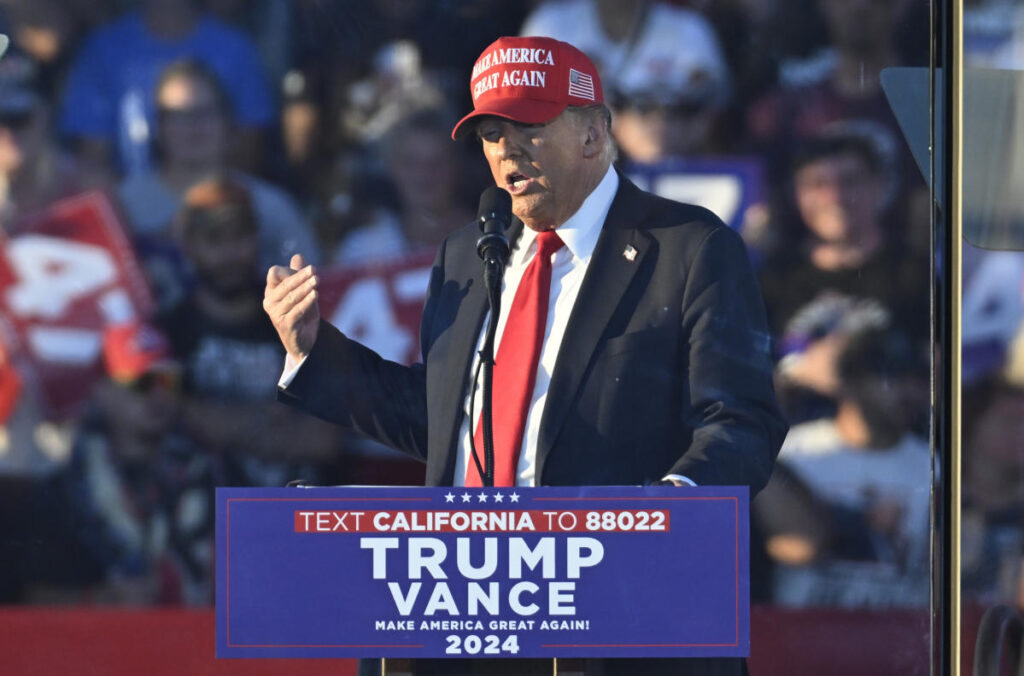At a recent rally in Coachella, California, former President Donald Trump made headlines for his inflammatory remarks directed toward a protester. While addressing the crowd, he dismissed the demonstrator by suggesting she should “go back home to Mommy” in a mocking tone. Trump’s comments escalated as he added, “And she gets the hell knocked out of her,” illustrating his penchant for violent rhetoric when confronted by dissenting voices at his events. This incident is part of a broader pattern of behavior exhibited by Trump, where he employs aggressive language to energize his supporters and disparage opponents or critics.
The protester was removed from the rally amid the crowd’s jeers, an atmosphere that Trump often cultivates at his events. His dismissal of the protester underlines how he engages with audiences; he frames confrontation with dissenters as something worthy of ridicule. By suggesting that the protester should return home while invoking the image of her mother, he aimed to diminish her presence and assert control over the narrative. The still-unclear circumstances of the protester’s actions during the event suggest varying levels of dissent can provoke severe reactions from Trump and his followers.
Historically, Trump’s rallies are marked by a charged atmosphere, often filled with partisan fervor and crowd participation. This creates a space where his supporters feel emboldened to express hostility toward dissenters. Trump’s past comments during the 2016 campaign have set a precedent for his supporters to respond aggressively to protests. He previously encouraged rally-goers to “knock the crap” out of protesters and even expressed a desire to physically confront an individual by stating, “I’d like to punch him in the face.” Such statements contribute to an environment of intimidation that critics argue can lead to real-world violence.
In his Coachella remarks, Trump’s comments drew a sharp contrast to rhetoric that advocates for peaceful discourse and democratic engagement. Instead, he relies on classic strategies of demonizing opposition, thereby reinforcing an “us vs. them” mentality among his supporters. By painting protesters as adversaries, he not only galvanizes his base but also solidifies a narrative where dissent is not just unwelcome but met with hostility and derision. This tactic ensures his speeches resonate with those who hold strong allegiance to his ideologies while alienating those who oppose him.
Key to understanding Trump’s approach is recognizing how language shapes the response of the audience. By using violent imagery and combative language, he mobilizes emotional reactions, drawing on feelings of frustration that often arise in polarized political climates. His comments serve to dehumanize the protester, reducing her to a caricature rather than recognizing her as a legitimate voice of opposition. This strategy effectively distracts from the substance of the protest and shifts focus to the spectacle of the moment, reinforcing the loyalty of his supporters through a shared experience of indignation and aggression.
Overall, Trump’s rhetorical style, with its reliance on projecting strength through violent language, has significant implications for political discourse. The Coachella event exemplifies a trend where confrontational politics overshadow constructive conversation, pushing the boundaries of acceptable political conduct. As rallies continue to serve as platforms for such rhetoric, the ongoing repercussions reflect an increasingly polarized society where dissent is often met with hostility rather than dialogue. The challenge remains in addressing how this cycle can be disrupted to foster a political environment where varying viewpoints are engaged with respect and civility.

